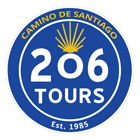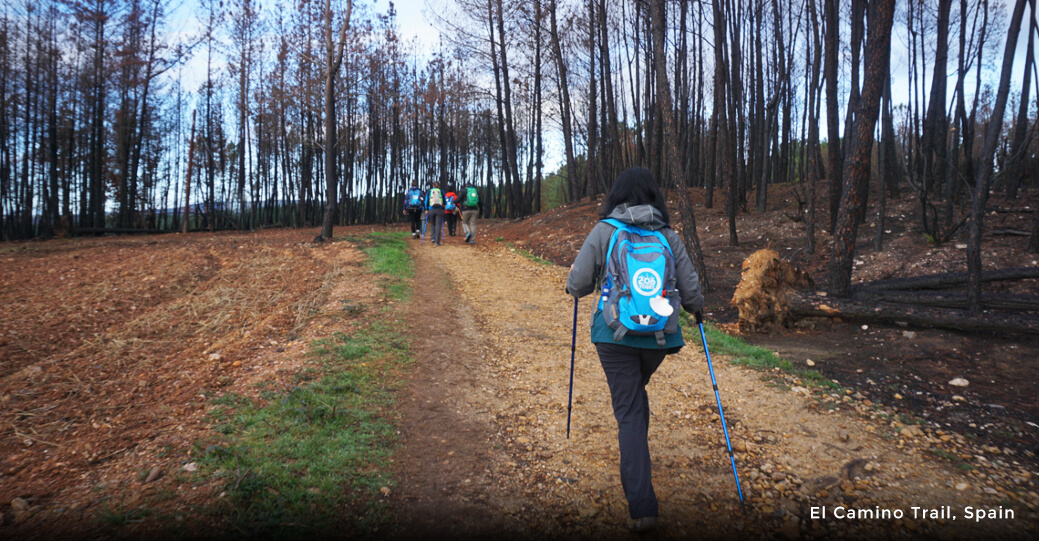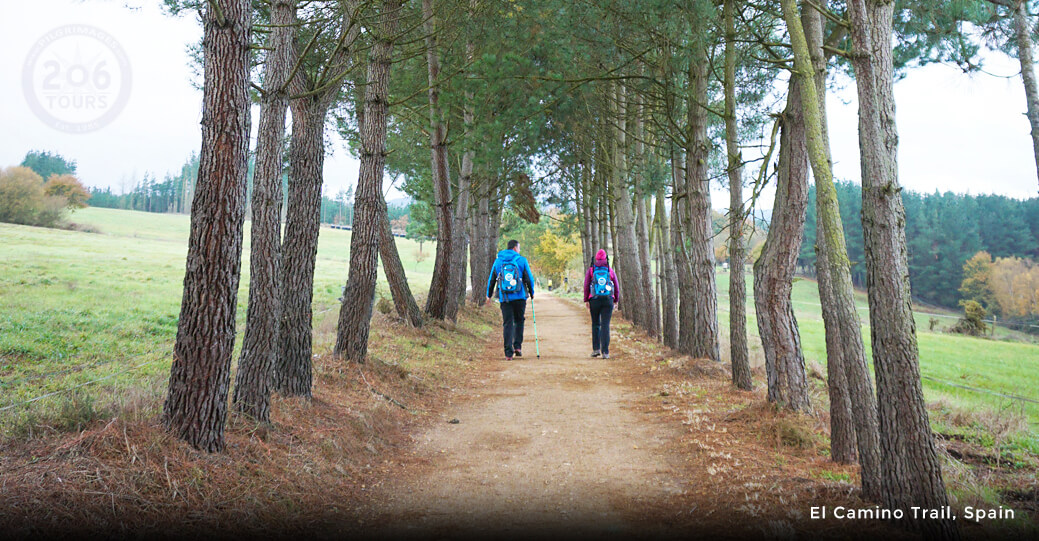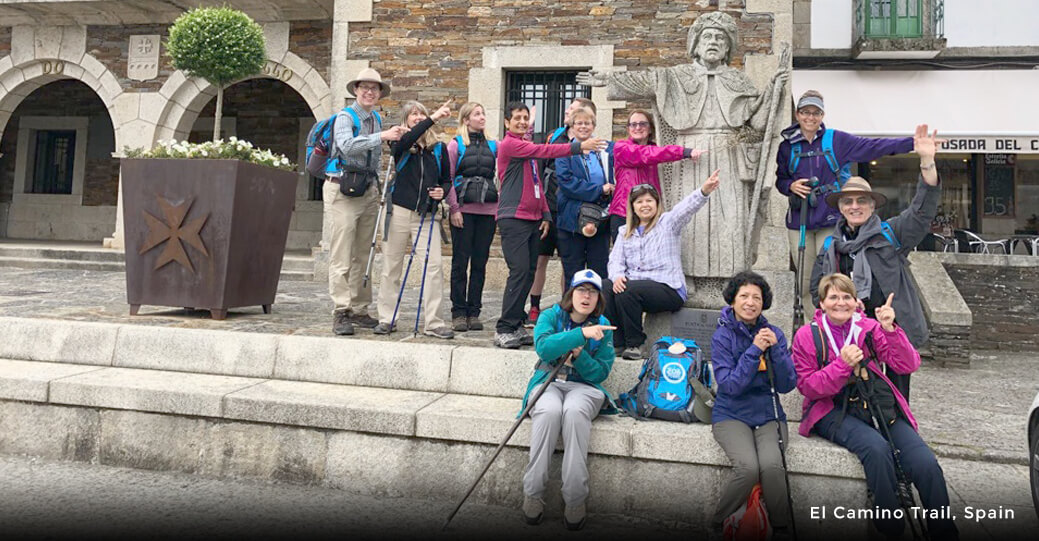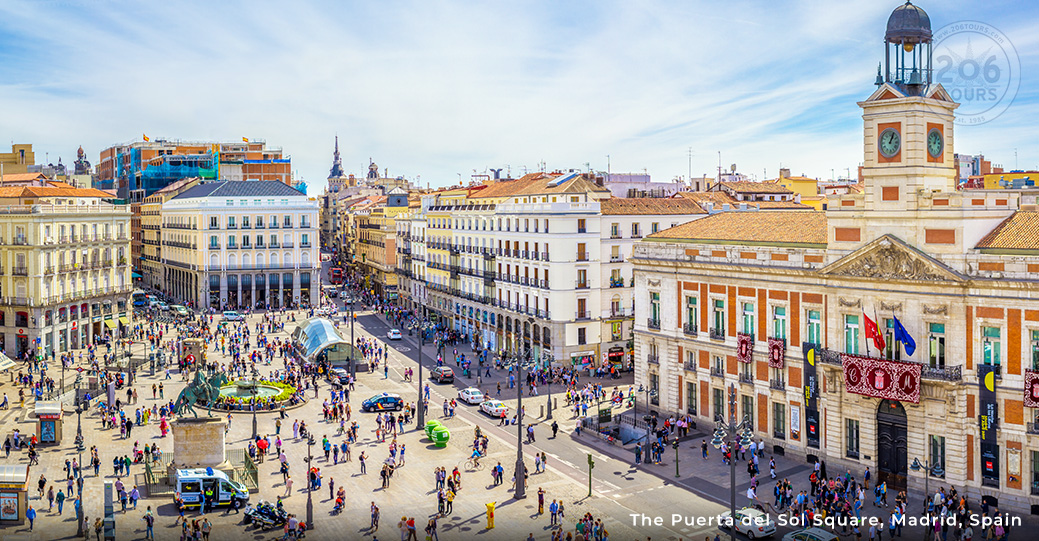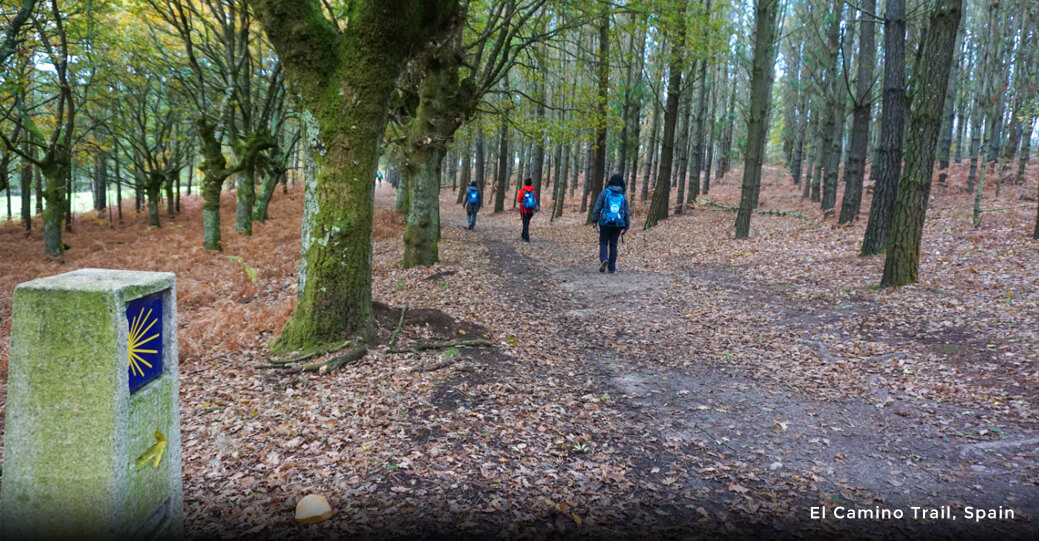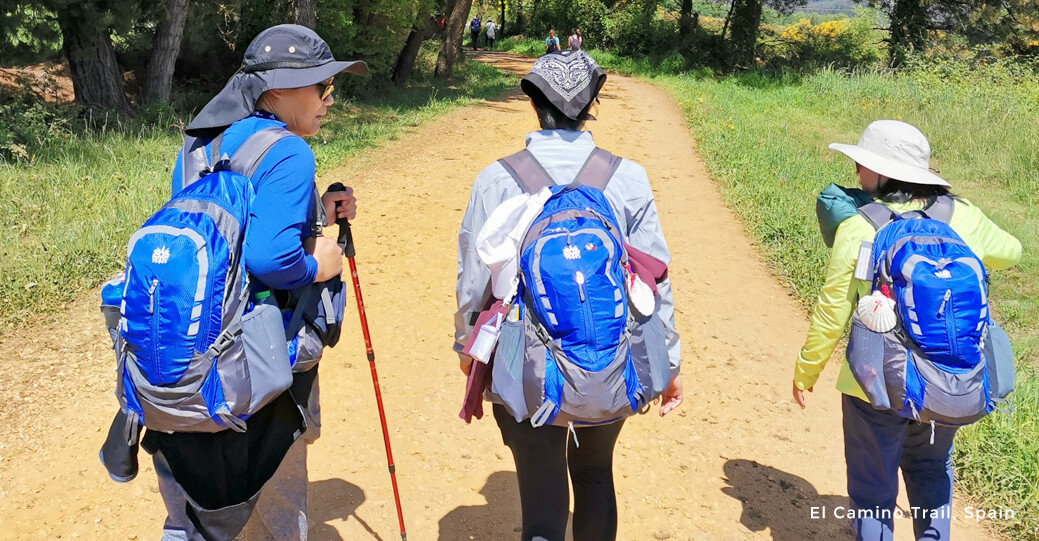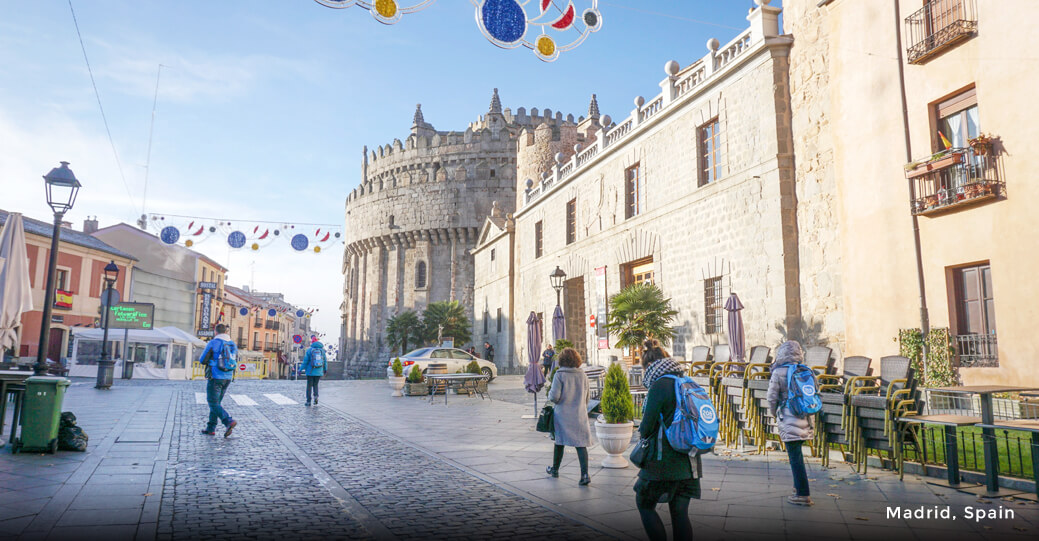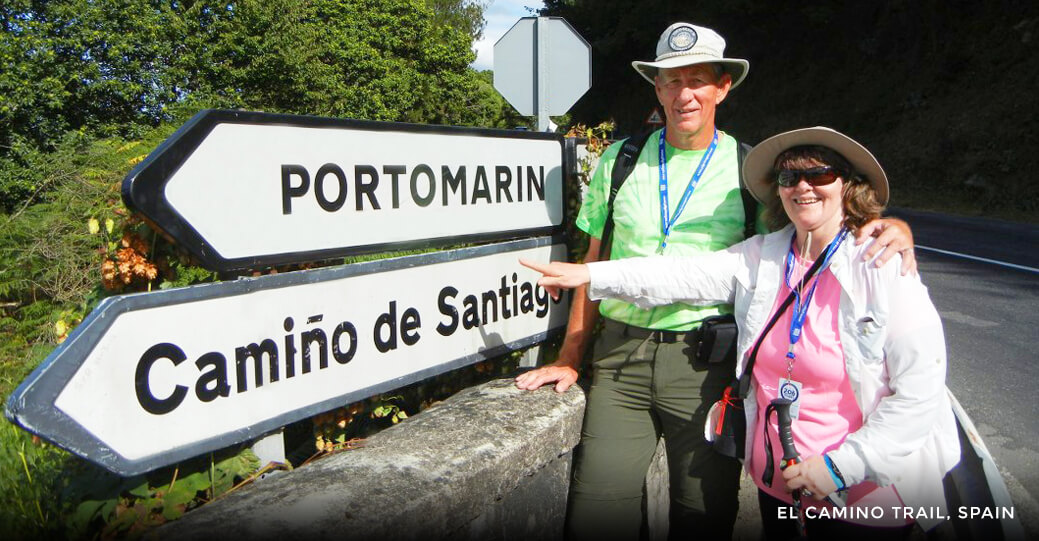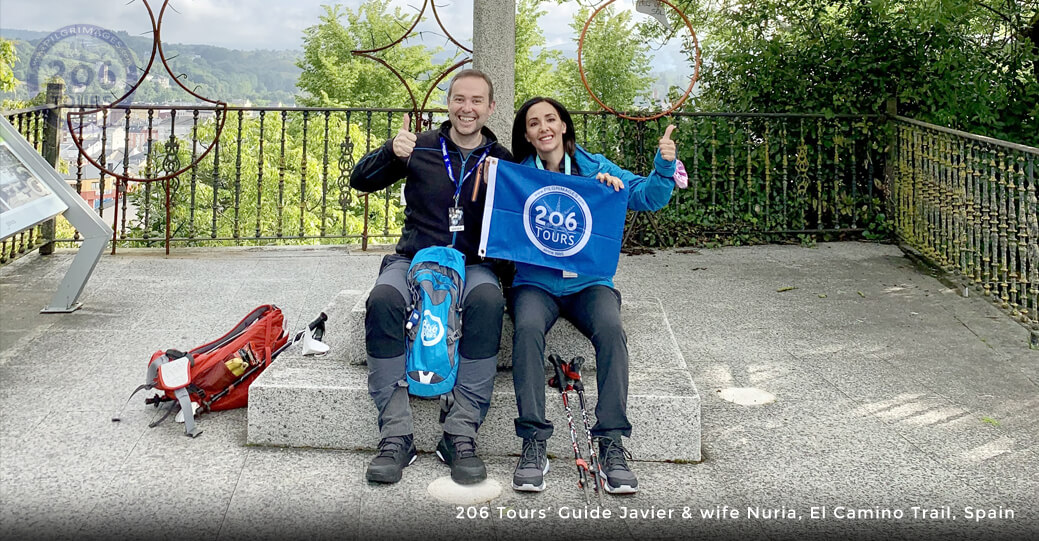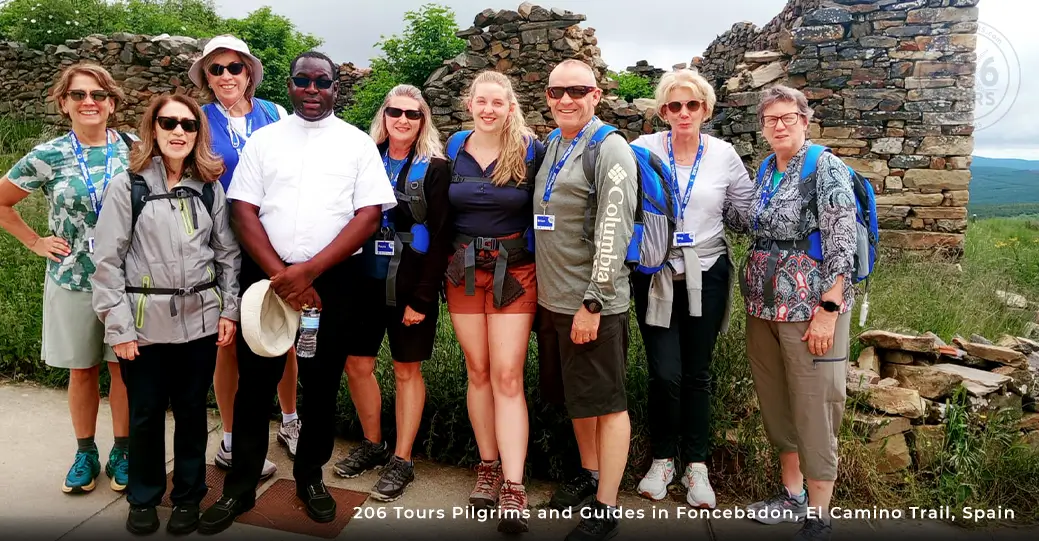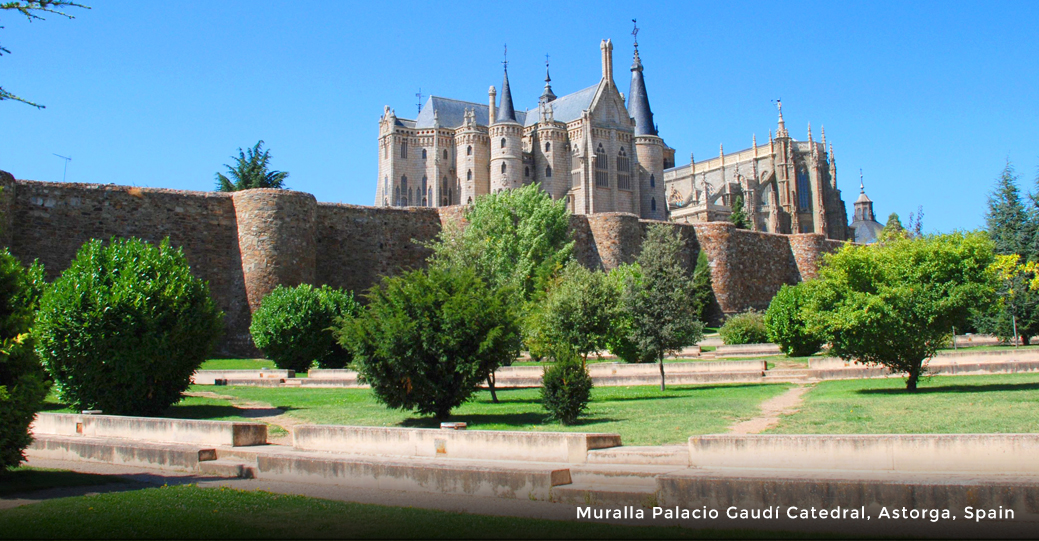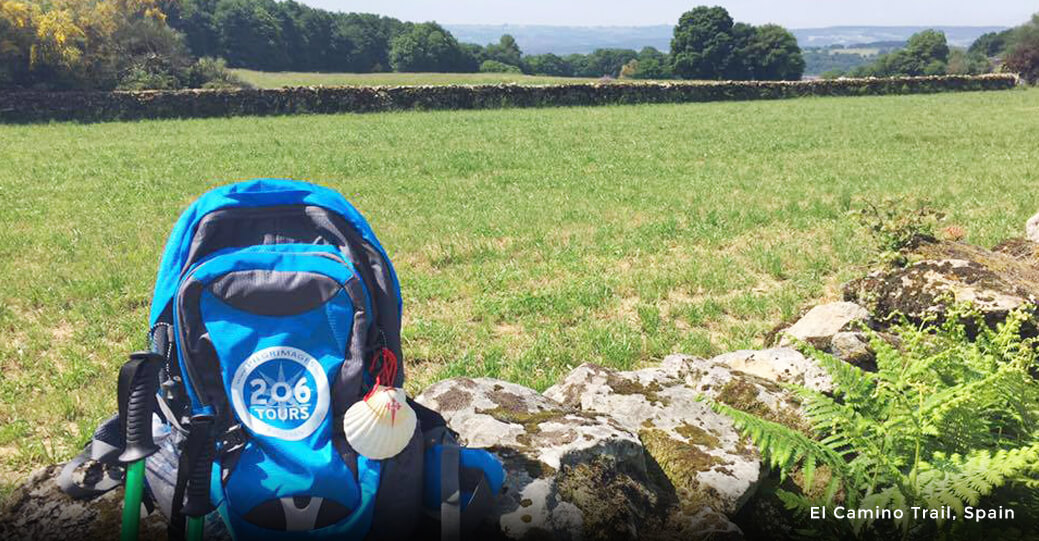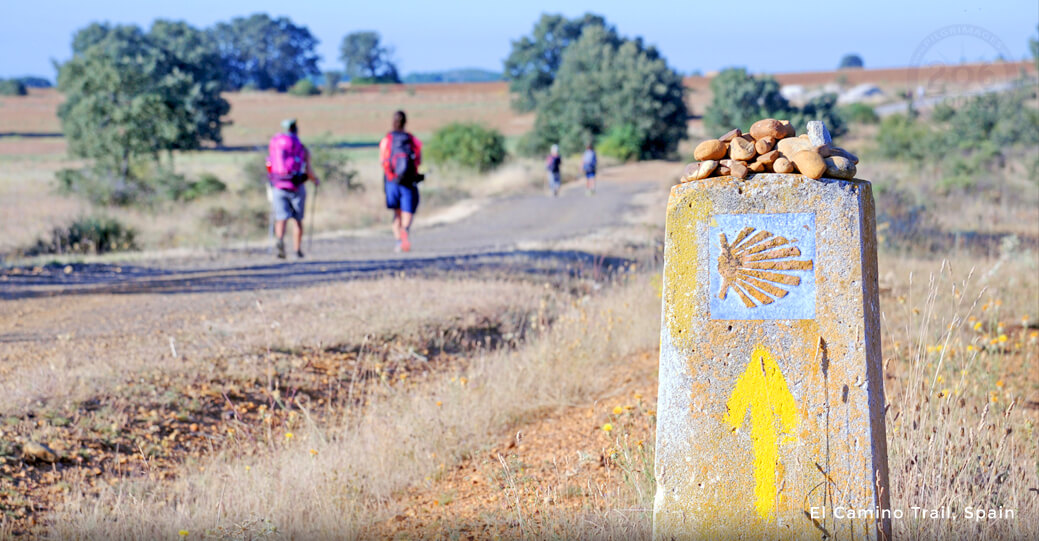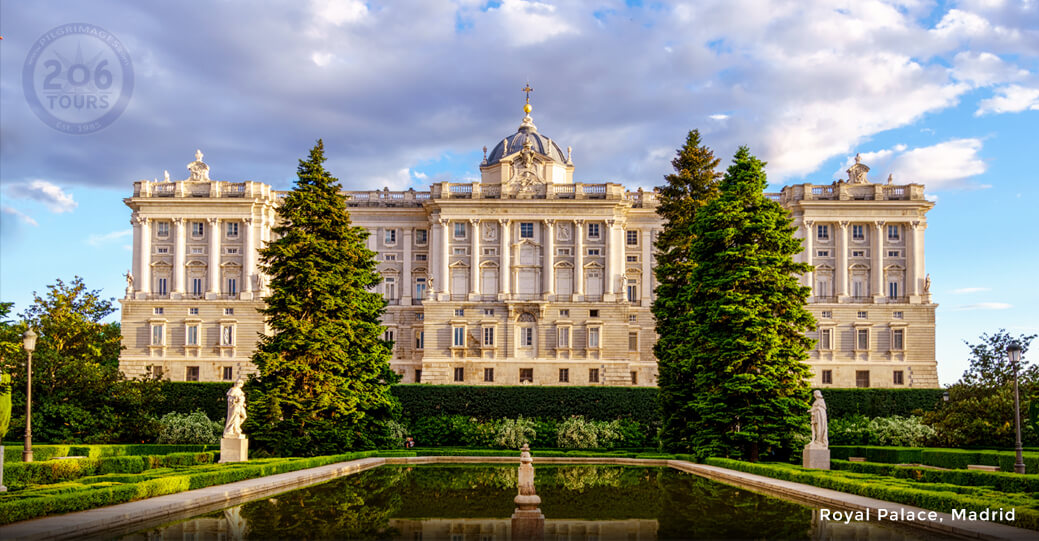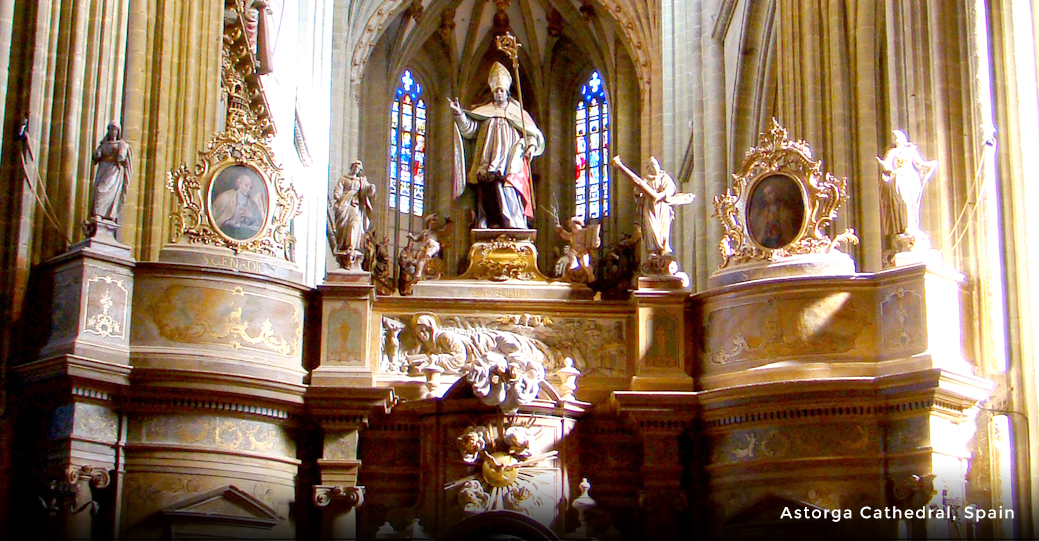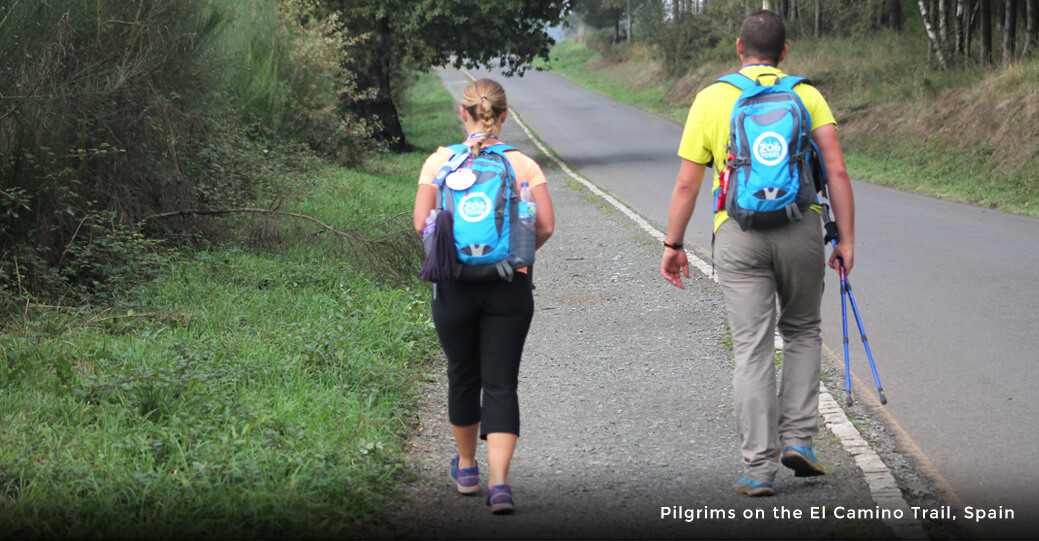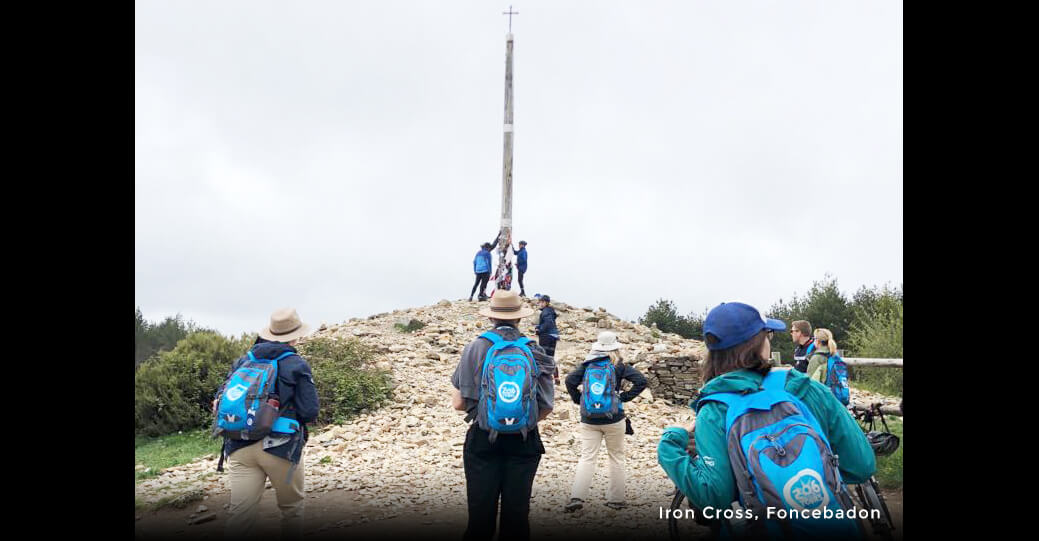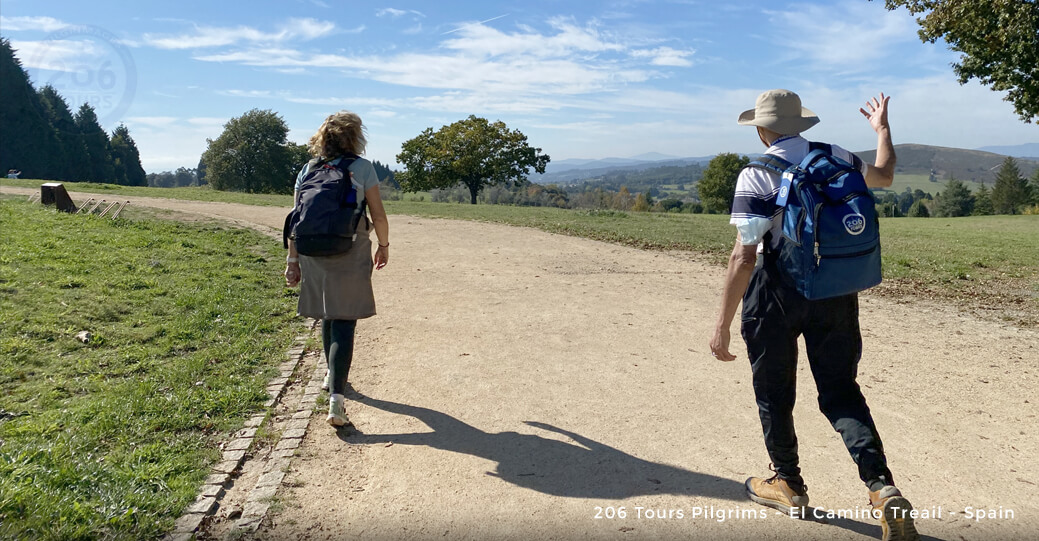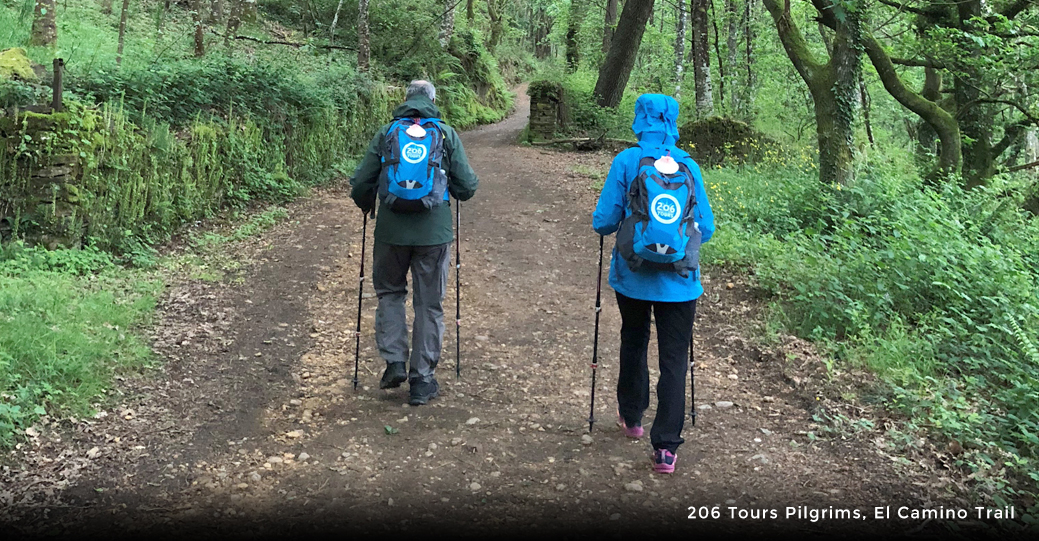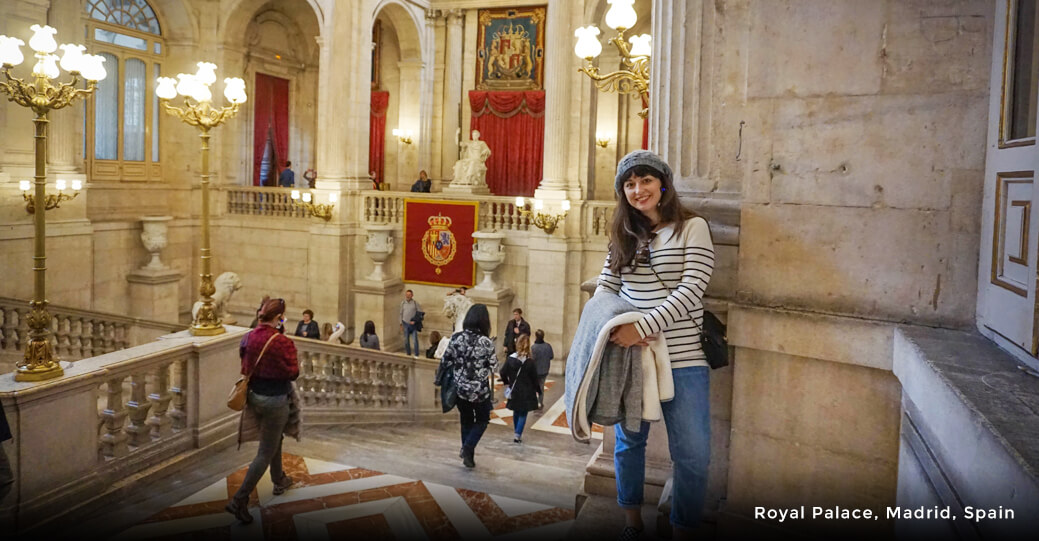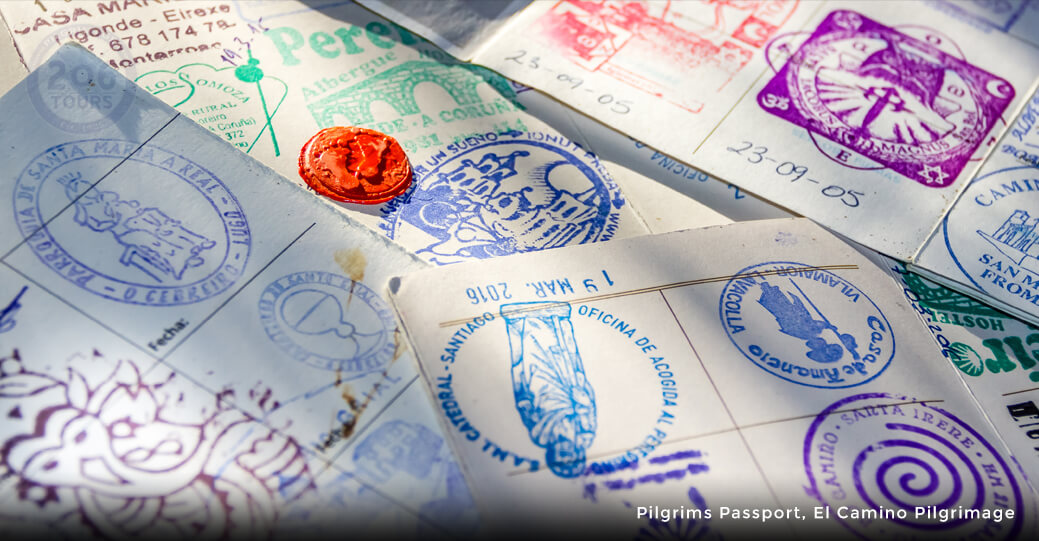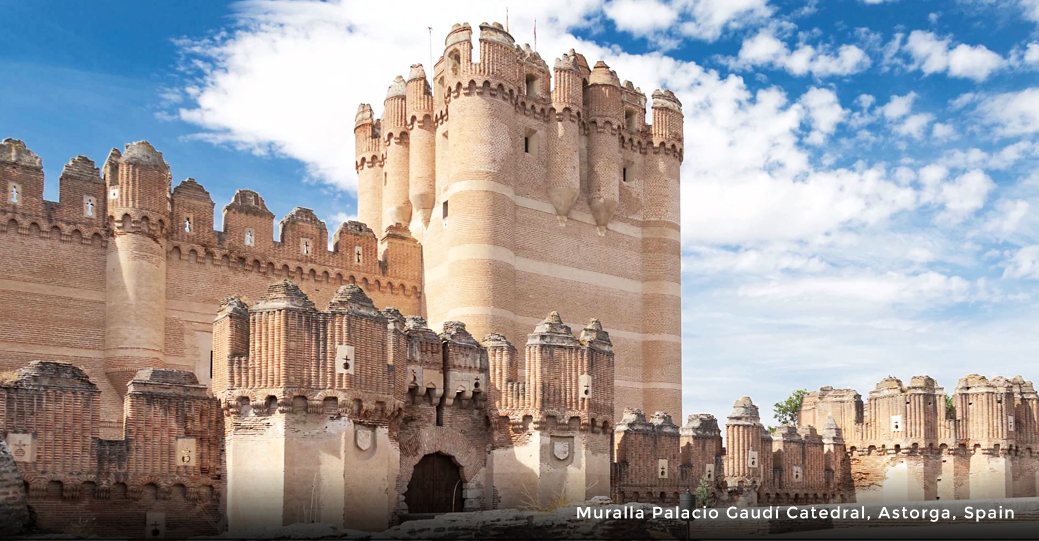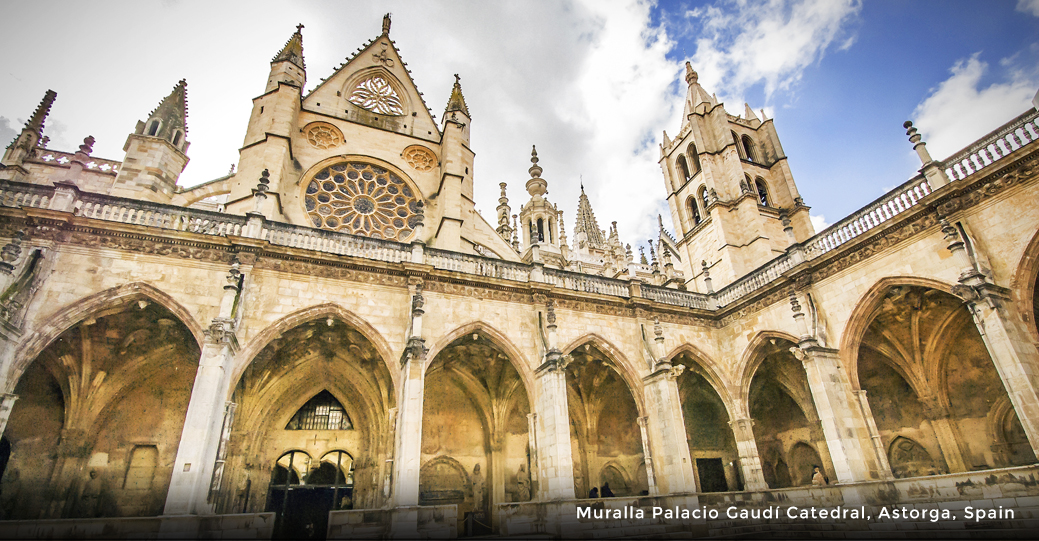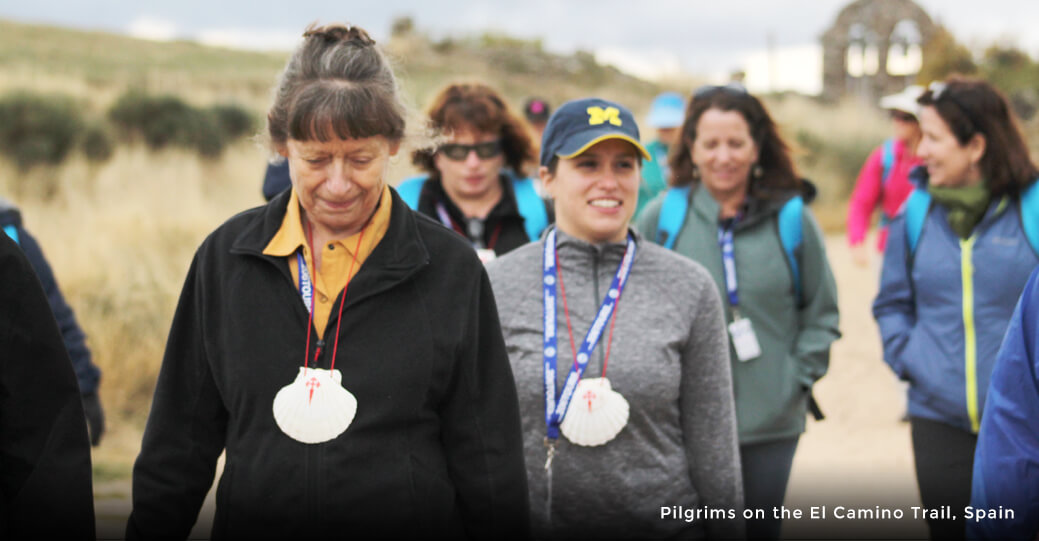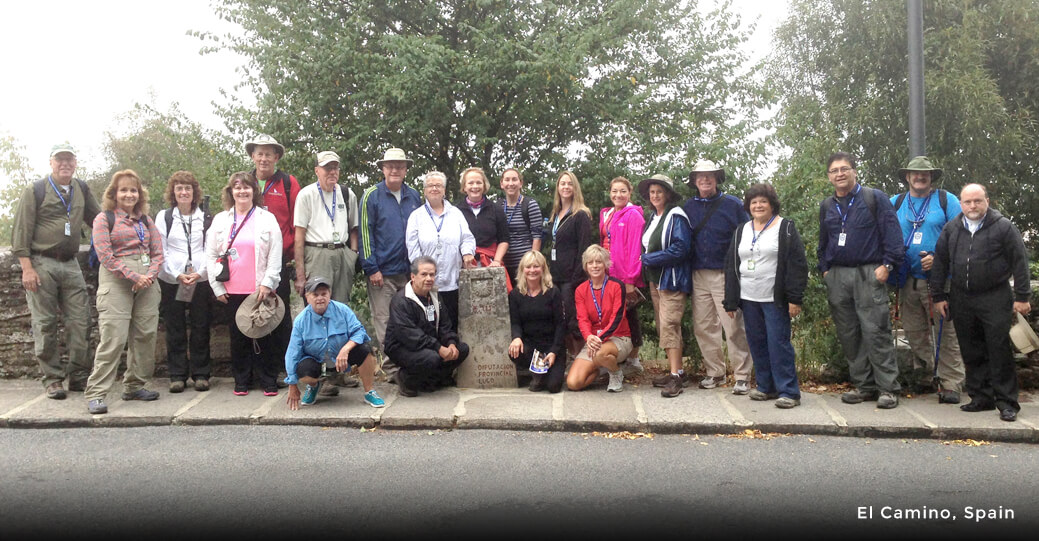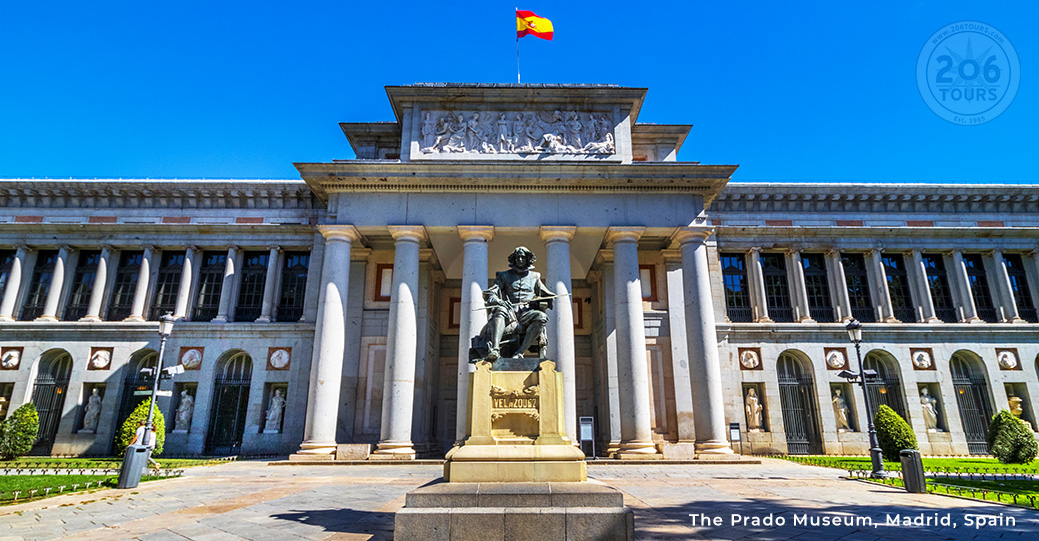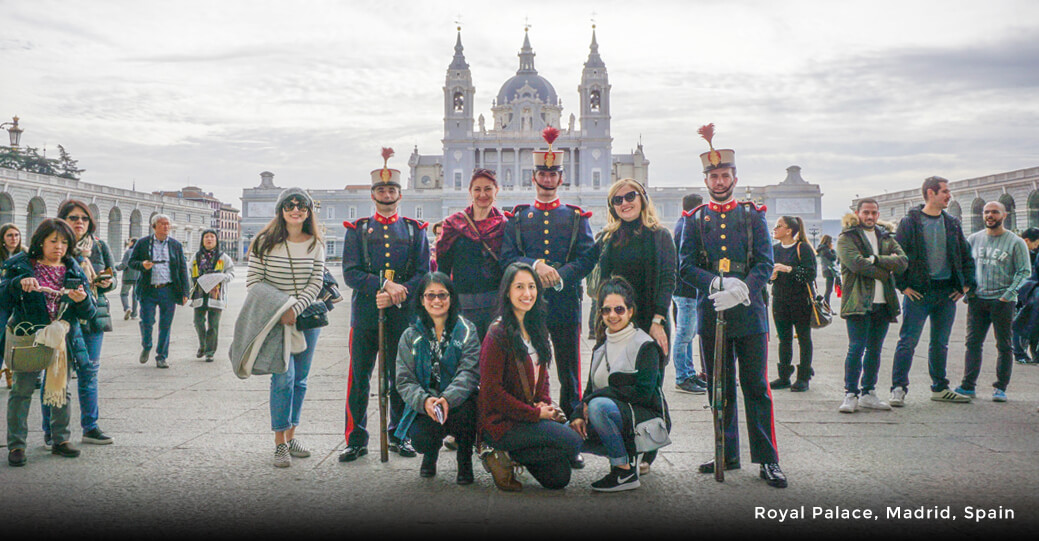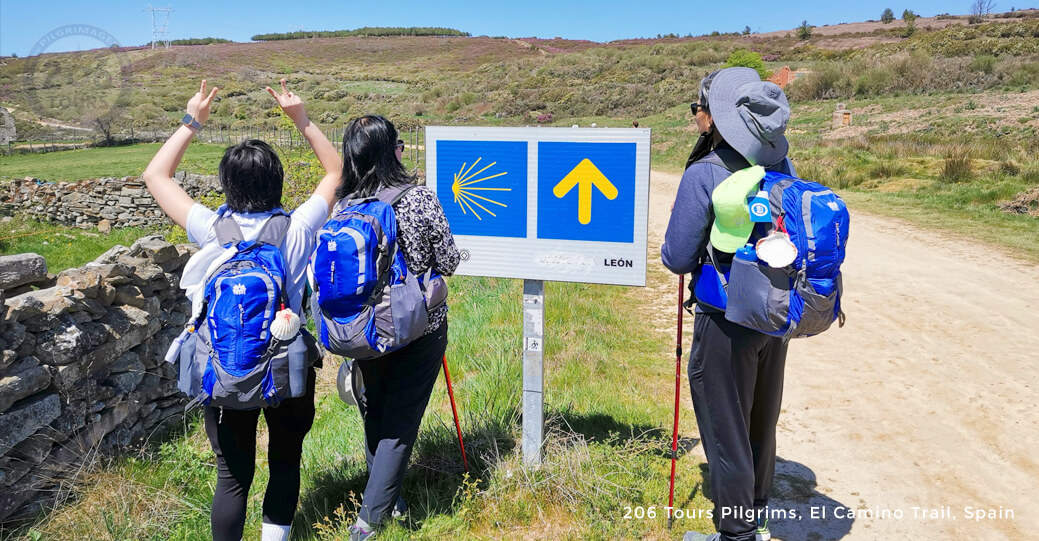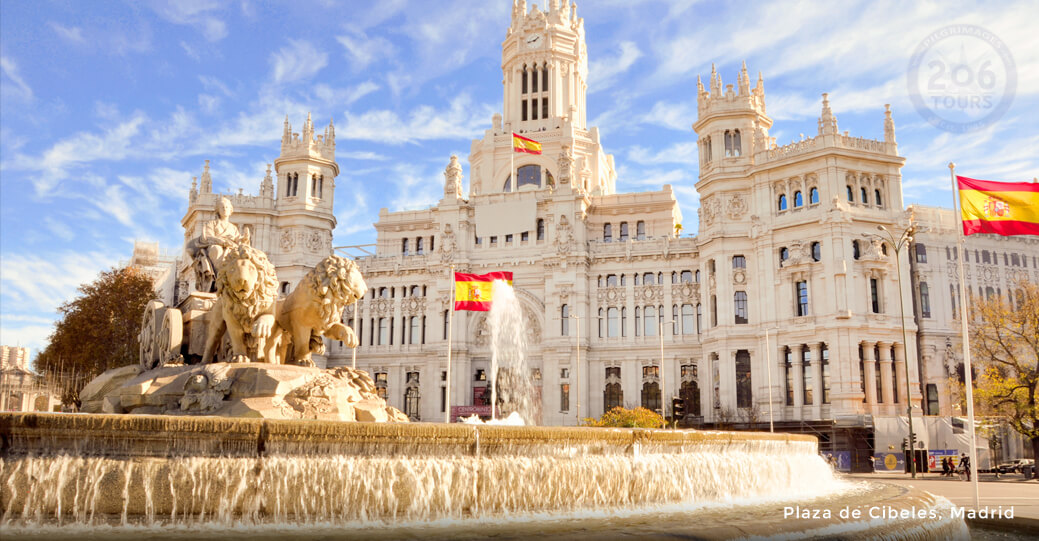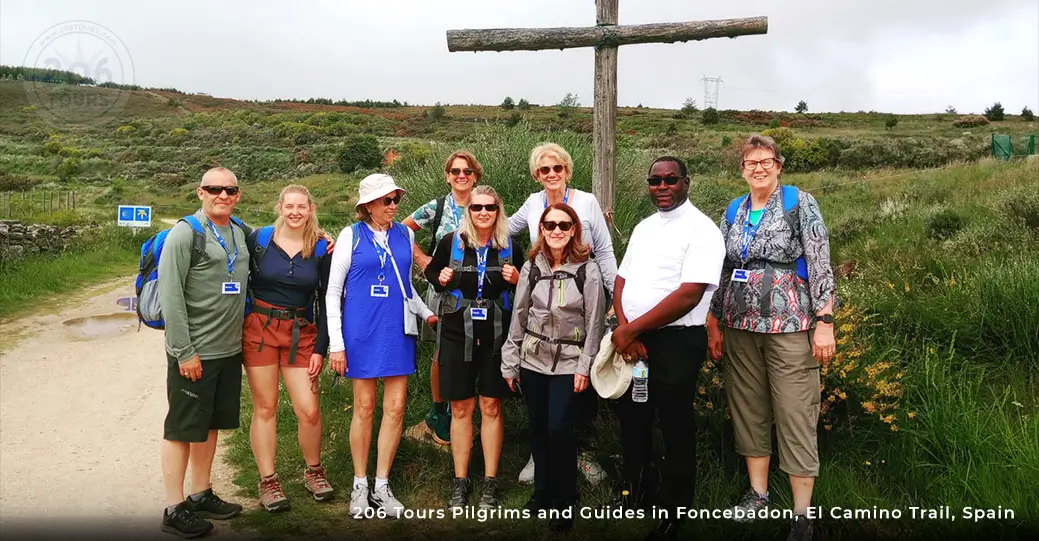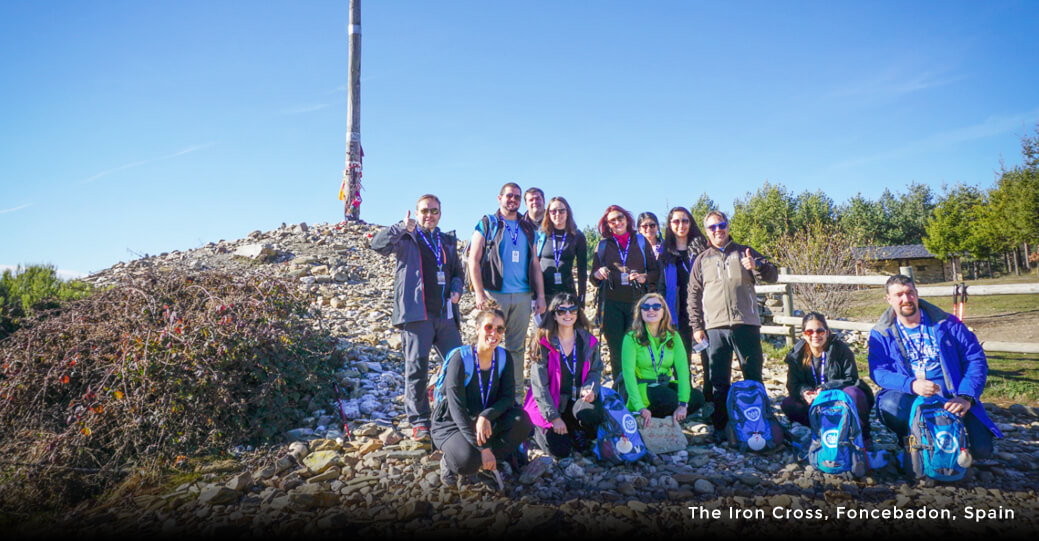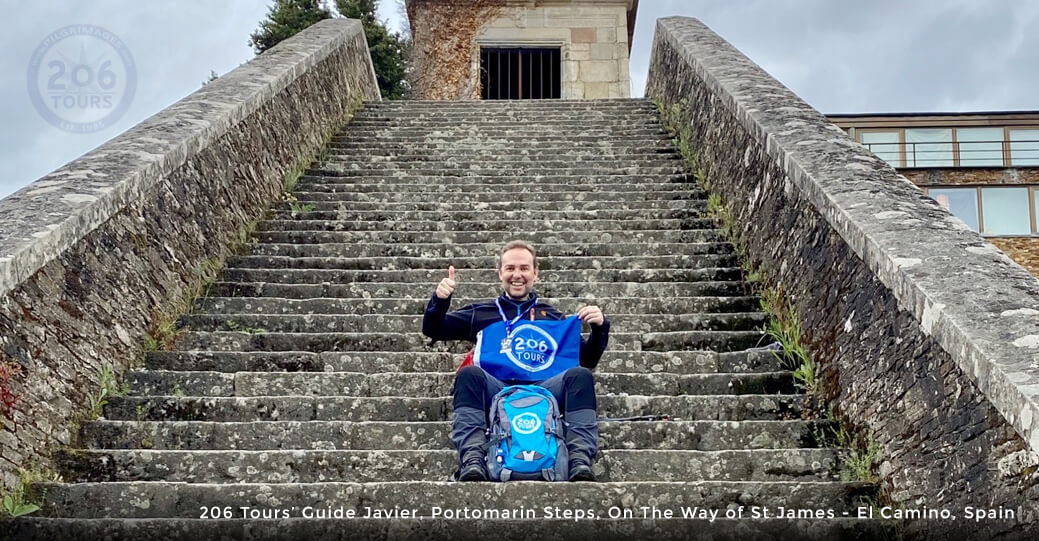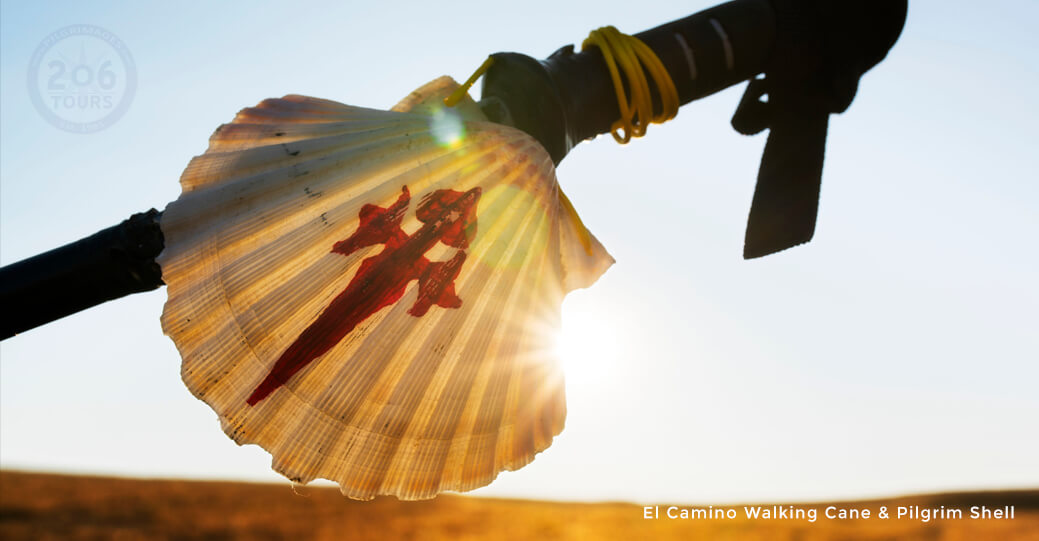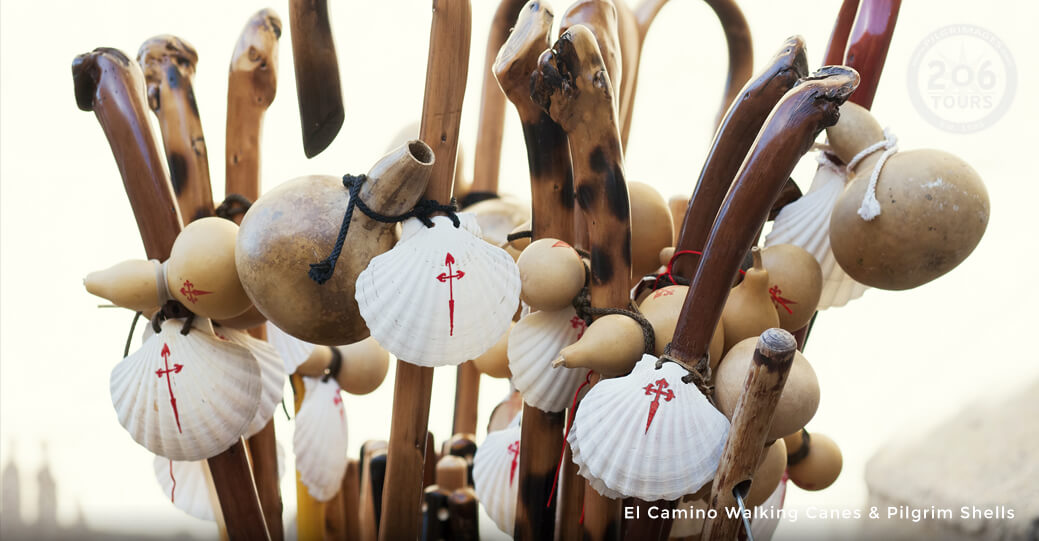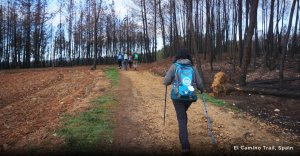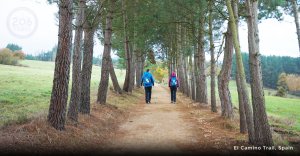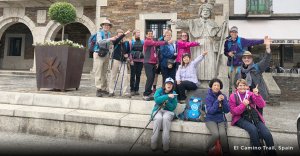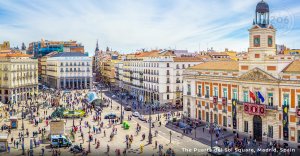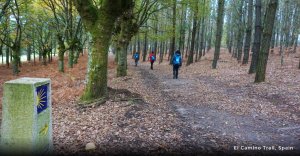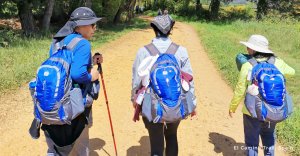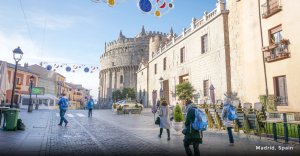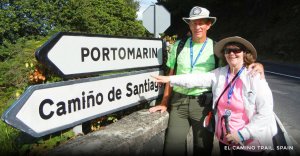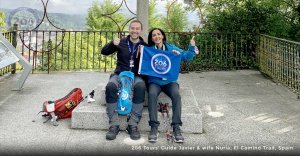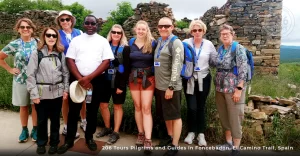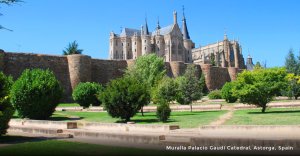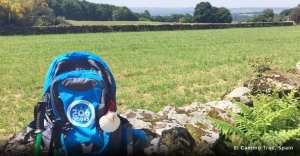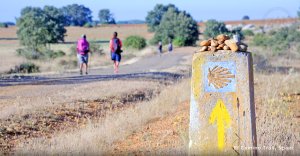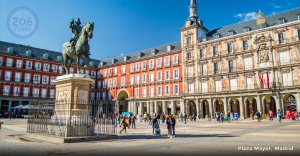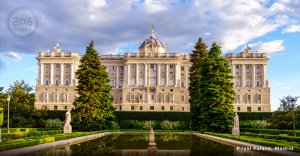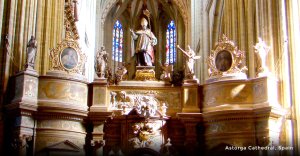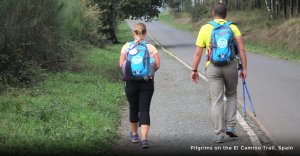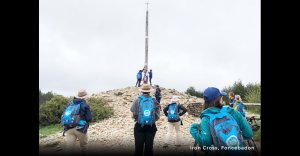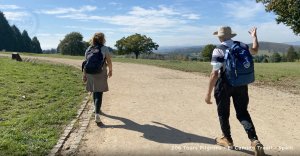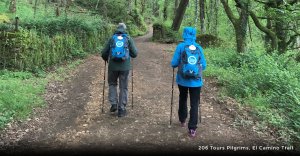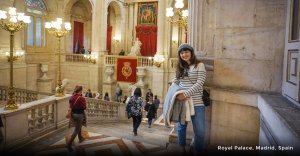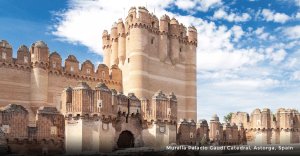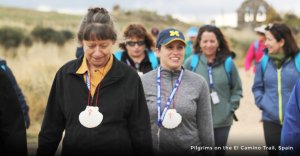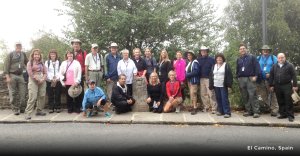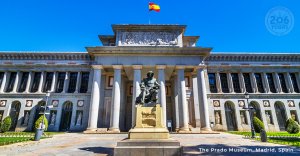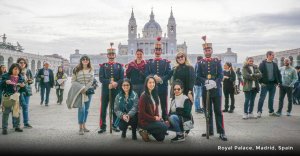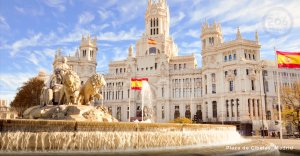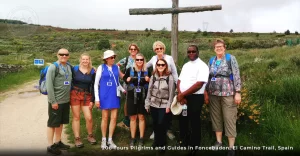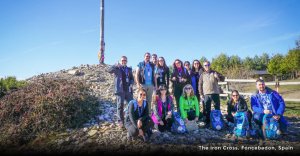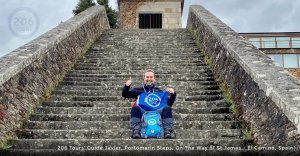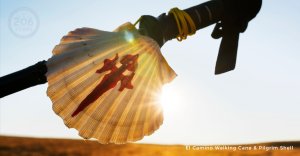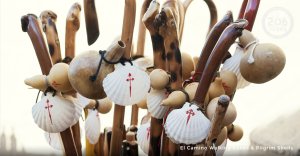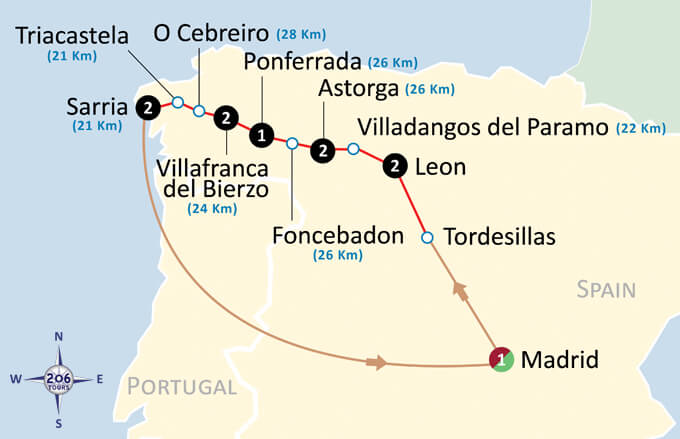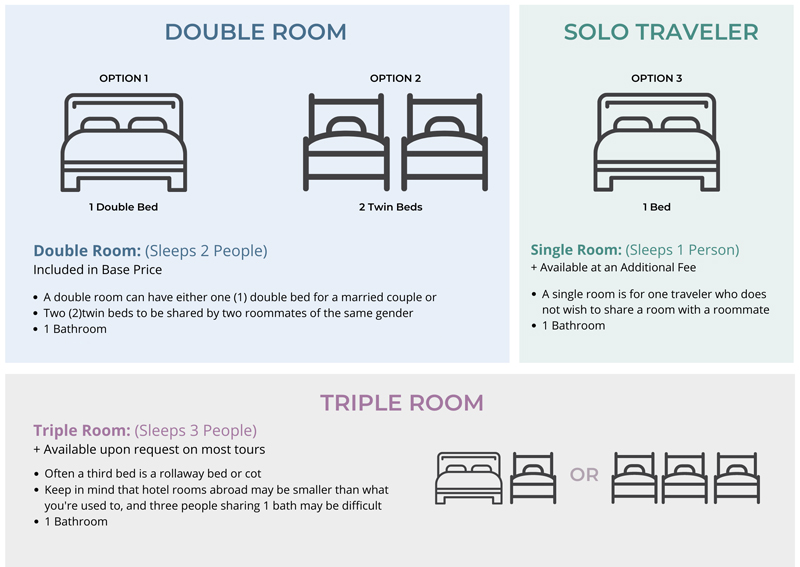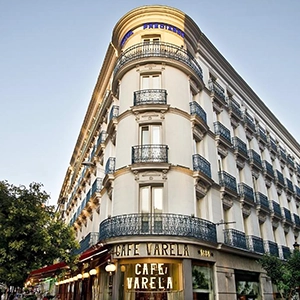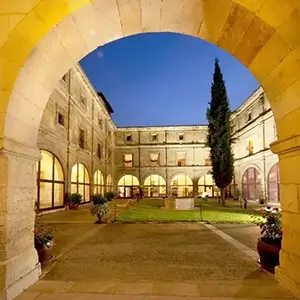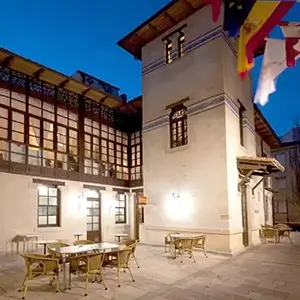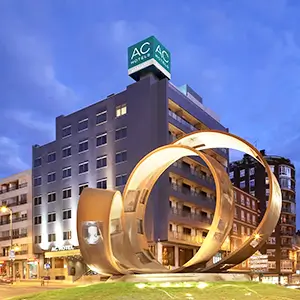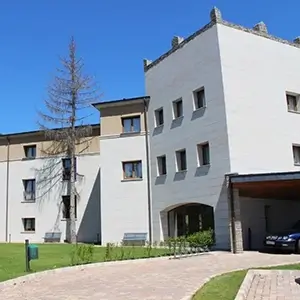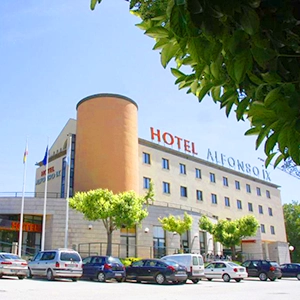Your trip includes
- Round-trip airfare from your desired Airport
- Prepaid seat assignments
- All airport taxes & fuel surcharges
- Hotel accommodations: (or similar) in double occupancy
- ~ 1 night: Preciados, Madrid, Spain
- ~ 2 nights: Hotel Real Colegiata San Isidoro, Leon, Spain
- ~ 2 nights: Hotel Spa Ciudad de Astorga By PortBlue Boutique, Astorga, Spain
- ~ 1 night: AC San Ponferrada, Astorga, Spain
- ~ 2 nights: Parador de Villafranca del Bierzo, Villafranca del Bierzo, Spain
- ~ 1 night: Hotel Alfonso IX, Sarria, Spain
- ~ 2 nights: Preciados, Madrid, Spain
- Breakfast daily
- 9 Lunches
- Dinner Daily
- Wine and mineral water with dinners
- Transfers by air-conditioned coach or minibus
- Free WiFi & Water on bus
- Vehicle available to assist pilgrims who are unable to complete any leg of the tour
- Tour Escort throughout
- Local guide in Tordesillas, Leon, Astorga and Ponferrada
- Daily Maps
- Transfers as per itinerary
- Catholic Priest, Mass daily & Spiritual activities
- Hotel taxes and service charges
El Camino Accommodations:
Please be advised that we book you in the best available accommodations that are along the Camino trail. There are a limited number of places to stay along the Camino trail, without having to walk extra miles away from the Trail, and then back to the Trail to continue walking the route. These places range in Star Rating – simply because luxury hotels just do not exist.
While you will be removed from the routine of your everyday life, rest assured you will be taken care of with outstanding accommodations, meals and transportation with van / bus driving parallel to the path you walk each day. Should at any point you feel tired, need water, or any medical assistance, it will be readily available to you at check points that are set up along the way on your path. Tourists pass through places, places pass through Pilgrims.
Not Included
- Lunches and Beverages not mentioned, items of a personal nature, tips to guide and driver
Itinerary
While you will be removed from the routine of your everyday life, rest assured you will be taken care of with outstanding accommodations, meals and transportation with van / bus driving parallel to the path you walk each day. Should at any point you feel tired, need water, or any medical assistance, it will be readily available to you at check points that are set up along the way on your path. Tourists pass through places, places pass through Pilgrims.
*Important Notice:
This itinerary involves an average of 13 – 20 miles daily of walking/hiking. It is essential that participants be in fit condition in order to complete the journey. We will have assistance vehicles (motor coach) available to assist pilgrims who are unable to complete a particular leg of the journey.
Day 1: Depart to Madrid
Make your way to your local airport, where you will board your overnight flight(s). Your meals will be served on board.
Day 2: Madrid Airport – Madrid
Upon arrival in Madrid, you will collect your luggage in the baggage claim area, and continue to the arrival hall where you will be greeted by your driver/tour escort and transferred to your hotel. Dinner and overnight in Madrid.
Day 3: Madrid - Tordesillas - Leon
After breakfast we will depart for Leon. On our way, we will make a stop at the town of Tordesillas, where the Treaty of Tordesillas was signed. The Treaty divided “All Lands Discovered, or Hereafter to be Discovered in the West, towards the Indies or the Ocean Seas” between Spain and Portugal. Further fame was brought to Tordesillas by the unfortunate Juana la Loca (daughter of Queen Isabella of Castile), who spent 46 years in a windowless cell in the Real Monasterio de Santa Clara, known as “The Alhambra of Castile” for its delightful Mudéjar architecture. Built as a royal palace by Alfonso el Sabio (the Wise) in 1340, its prettiest features are the tiny “Arab Patio” with horseshoe arches and Moorish decoration, and the superb coffered ceiling of the main chapel. We will continue our journey to Leon. Lying on the banks of the Bernesga River, Leon is the last major city before we reach Santiago and before we climb through the mountains of the Cordillera Cantabrica. The city was founded as a Roman fort in 68 A.D. to protect the roads leading to the gold mines at El Bierzo, a little to the west. The town was home to the Legio Septima or Seventh Legion of Imperial Rome, from which the city is believed to get its name. Leon was Christianized in the 3rd century, becoming the oldest Bishopric (diocese of a bishop) in western Europe. Enjoy dinner and overnight in Leon.
Day 4: Leon – Villadangos del Páramo (22 km)
After breakfast in the hotel, we will start our pilgrim walk towards Santiago de Compostela following the scallop shells that pass by the Real Collegiate of San Isidoro and towards San Marcos. The first village we will encounter on our way is La Virgen del Camino (Our Lady of the Way). Catholic tradition says that during the feast of the Visitation in July 1505, the Virgin Mary appeared to a local shepherd while he was taking care of his flock. She asked him to go to the city, find the Bishop, and bring him to this place to build a shrine in her honor. He asked the Virgin Mary how the Bishop would know that it was she who sent him. The Virgin Mary, seeing that he had a slingshot in his hand, asked him to pass it to her. She picked up a small stone and put it into the slingshot. She told the shepherd that wherever this stone landed, that is where she wanted her shrine to be built. The shepherd set off to speak to the Bishop in Leon and told him of the apparition. He was unconvinced until the shepherd, using his slingshot, hurled a stone which promptly became a boulder when it struck the ground. Now convinced of the miracle, the Bishop built a hermitage dedicated to the Virgin Mary. The very modern church that stands in the place where the original hermitage had been is the Church of the Virgen del Camino, which was built in 1961 and is managed by Dominican friars. We will follow the old Roman road that linked Astorga with Leon. At the end of this walking stage, we will arrive at the village of Villadangos del Páramo. Here, we will find the Church of Saint James, where at its entrance we will see a carving depicting the legendary battle at Clavijo in 844. It is at this battle that Santiago, in his guise as Santiago Matamoros, is reputed to have helped the vastly outnumbered Christian army. Enjoy dinner and an overnight.
Day 5: Villadangos del Páramo - Astorga (26 km)
Begin your day with breakfast at the hotel. After attending Mass at Saint James Church in Villadongos del Paramo, we will continue our walking pilgrimage. The first large village we will find today is Hospital de Orbigo. To get to this beautiful village, we will have to cross the longest bridge on El Camino (670 feet), which has a lovely story related to it. The bridge is called El Paso Honroso, which means “the honorable pass”. The name was given due to a jousting tournament of sorts undertaken by Don Suero de Quiñones. Don Suero was in love with a lady named Doña Leonor de Tobar, who unfortunately did not feel the same way. This 15th-century knight, considering himself a prisoner of her love, decided to wear an iron collar around his neck every Thursday as a symbol of being enslaved by his love for her. As a way to impress both the lady he loved and King John II of Castile, as well as a way of freeing himself from his enslavement, he decided to embark on a surprising joust in the style of the knights of old. Don Suero offered the tournament to Saint James, saying that he and nine other knights would challenge those undertaking the pilgrimage to Santiago until 300 lances were broken. When the tournament was finished, all the participants went to Santiago de Compostela to offer their arms with which they had fought to the Apostle. The tradition says that the iron collar worn by Don Suero was turned into gold and is hung around the neck of the image of the Apostle that is used in processions. We will find the Church of Saint John the Baptist on the other side of the bridge and what remains of the pilgrim hospital that had been built in the 12th century by the Knights of the Order of Saint John of Jerusalem. At the end of today’s walking stage, we will arrive at the walled city of Astorga. This historical and religious city, called Asturica Augusta by the Romans, was one of the Roman strongholds in the Leon area. This is where the French and Plata Routes to Santiago converge. The extraordinary Gothic Cathedral, from the 15th century, presides over the town. The Episcopal Palace or Gaudí Palace houses the Museo de los Caminos, which displays pieces from all churches related to the Route to Santiago. Pilgrims will also enjoy the chocolate museum that celebrates Astorga’s chocolate industry, which thrived during the 18th and 19th Centuries. Enjoy dinner and an overnight.
Day 6: Astorga - Foncebadón (26 km)
After breakfast in the hotel, we will attend Mass at the Cathedral of Astorga. Today, we will journey through an area called La Maragateria, ending in the Bierzo region that borders Galicia. Walk through Murias de Rechivaldo, a lovely village with most of the stone buildings constructed in the traditional Maragato style. Here we will find the Church of Saint Stephen with a carving of Our Lady of the Pillar above its door; Santa Catalina de Somoza, where we will see the Church of Saint Mary that houses a relic of Saint Blaise, the town patron saint; and El Ganso, with its thatched houses which are typical of the North-Western part of Leon and Galicia. Before arriving at Rabanal del Camino, we will pass the remains of the Roman gold mines of La Fucarona, one of the oldest gold mines in the region. In the Middle Ages, Rabanal del Camino was an essential stop for pilgrims before they walked through the mountains. It was a large settlement of the Templar Knights who used to defend and protect the pilgrims from the robbers of the harsh areas of Foncebadón. There is a community of Benedictine monks living in the San Salvador del Monte Irago Monastery who came from Santo Domingo de Silos in 2001. Currently, the monastery is affiliated with the Abbey at St. Otilien in Germany. The next village that appears, and the end of our stage, is Foncebadón. This was an important village during the Middle Ages, but it has now been abandoned. Notably, a Council took place in Foncebadon in the 10th century, and a century later, the hermit Guacelmo founded a hostelry for pilgrims. Relax with an enjoyable dinner and restful sleep.
Day 7: Foncebadon - Ponferrada (26 km)
Begin your day with breakfast in the hotel. Some kilometers off the municipality of Foncebadón, you can see the Ferro Cross on top of a stick fixed to a big heap of stones. Traditionally, pilgrims bring a stone from their places of origin and deposit it on the heap. The end of today’s journey is located in Ponferrada. This town, with Prehistoric and Roman antecedents, had two access points in the Middle Ages. One was via the Roman bridge spanning the Boeza river; the other was via the path of the Gallegos and then, crossing the river by the Medieval bridge of Mascarón. At the end of the 11th century, the Bishop of Astorga, Osmundo, commissioned the building of a new bridge, “la Pons Ferrata”, a pass with iron banisters which gave name to the city. Later on, between the 11th and 14th centuries, the Castle of the Knights Templar was built. In the 15th century, the Catholic Monarchs commissioned the construction of the Hospital de la Reina, next to the fortress. In this monumental town also stand the Basilica of Nuestra Señora de la Encina, built to commemorate the apparition of the Virgin in a grove of Holm oaks, and the Baroque Church of San Andres, which is home to an outstanding retable: “The Christ of the Wonders”. Have dinner before retiring for the evening.
Day 8: Ponferrada – Villafranca del Bierzo (24 km)
Enjoy breakfast at your hotel. Today, part of our journey will follow the old Roman road that connected Ponferrada with the silver and gold mines located in Las Médulas. The first village we will see today is Cacabelos. Cacabelos began in the 10th century, but it can trace its origins all the way back to the Bronze Age. In the Middle Ages, the town boasted a few churches and some pilgrim hospitals. Nothing remains of these ancient buildings except the 18th-century Quinta Angustia Shrine. Here, we will find a very unusual carving of the child Jesus playing cards with Saint Anthony of Padua. At the end of today’s walking stage, we will arrive at Villafranca del Bierzo, the last major town along the Camino de Santiago in Leon, with the Galician village of O Cebreiro only 17 miles away. Villafranca del Bierzo is believed to have been founded by French monks of the Cluny order. The town largely owes its existence to El Camino, and both this and the many monuments found here make Villafranca del Bierzo a natural tourist destination. There is plenty to see but the most interesting buildings/monuments are: the Church of Saint James, that granted the privilege of providing absolution to the pilgrims who were too ill to continue along the Camino to Santiago; San Nicolas, founded as a religious school run by Jesuits until their expulsion in 1767; the Collegiate of Saint Mary that was built on the site of the original monastery of the Cluny order; Agua Street, full of palaces and emblazoned houses; the San Francis Church and the Castle of the Marquees of Villafranca. Have dinner and spend time with your fellow pilgrims before retiring for the evening.
Day 9: Villafranca del Bierzo – O Cebreiro (28 km)
Following breakfast, we will walk through the Ancares Valley, where we will be able to see the Castles of Sarracín, of which some ruins can be seen, and Veiga; both castles are connected to Celtic legends. Halfway through today’s walk, we will arrive at the village of Vega de Valcarce, where we will find a great example of a horreo or grain store. As we enter Galicia, we will see different horreo styles, typically constructed from granite or wood. The Camino from this point onwards until we get to O Cebreiro climbs up through the mountains. It starts off gently but progressively gets steeper. O Cebreiro, with an altitude of almost 4,000 feet, owes much of its existence to the Camino de Santiago as well as to the many Roman roads that passed this way. It is the first town we reach on the French Camino as we enter Galicia. The first pilgrim hospital to appear in the town was built in the 9th century and was run from the late 11th century by the monks of Saint Gérard De’Aurillac, a French religious order. Also in the 9th century, the monastery of the Sanctuary of O Cebreiro was built. Not much remains other than the Church of Saint Mary the Royal, considered to be the oldest intact church along the whole Camino. There is a Eucharistic miracle related to this church. In the 14th century, there was a parishioner from a nearby village called Barxamaior who climbed up to the church through heavy snow and a blizzard to attend Mass. As the priest was celebrating the Eucharist he had a momentary lapse of faith and whilst he was consecrating the bread and wine he thought to himself, while looking at the parishioner sat in front of him, “What is this man doing here in this cold weather, just to see a piece of bread and a little wine?”. It was at this point that the miracle occurred; the bread turned to flesh, and the wine became blood. This miracle became known locally as the Galician Holy Grail. The relics are kept in a reliquary given to the Church by the Catholic Monarchs whilst they were undertaking the Camino to Santiago in 1486, along with the chalice and paten used in that Mass. While we are here in O Cebreiro, we will be able to take a look at the Pallozas, the traditional round stone houses with thatched roofs that the people of this area used as their homes. Have dinner and a restful overnight.
Day 10: O Cebreiro – Triacastela (21 km)
Begin your day with breakfast. As we continue our walk throughout Galicia, we will pass through countless hamlets connected by ancient stone walls separating the trail from fields and cow pastures. We’ll enjoy the hearty Galician food, including leafy green soup, called caldo gallego, creamy cow’s milk cheeses, thick loaves of wheat, rye, and corn meal bread, outstanding Galician veal and pork, seafood, and greens such as cabbage, broad beans, Swiss chard, and leeks. Our halt today will be Triacastela. In the 13th Century, Alfonso XI tried unsuccessfully to convert this precious village into a big town. Triacastela once had a hospital and a prison, an unusual circumstance along the Route. Pilgrims can visit the Parish Church of Santiago, containing a façade from the 18th century and a Romanesque apse. In its interior, there is a processional cross from the 12th century. As a penance, pilgrims used to carry in their packs a piece of limestone from the mountains of Triacastela. End your day with dinner and an overnight.
Day 11: Triacastela - Sarria (21 km)
On today’s walk, we will reach the town of Samos. Here we will find the impressive Benedictine Monastery of San Julian de Samos. It was founded in the 6th century by San Martin Dumiense and renovated by San Fructuoso in the 7th century. Unfortunately, soon after the monastery was renovated, it was abandoned because of the Moorish invasion. The monks did not return until the Christian King Fruela I reconquered the area. This important monastery is situated in the valley by the Ouribio River, surrounded by scenery that enhances its beauty and provides a mysterious atmosphere. Its impressive Neoclassical façade is worthy of note, as well as the monumental cloisters. The cloister of Nereidas, from the 16th century, contains a beautiful fountain. The Cipres chapel, from the 10th century, is one of the oldest elements in the monastery. As we continue our walk, we will pass through a picturesque scene full of oaks and chestnut trees. At the end of the stage we will arrive in Sarria. Sarria was inhabited for many thousands of years by the Celts and the Romans, but the town itself was founded at the end of the 12th century by King Alfonso IX, the last king of Leon. He died here in 1230 from a serious illness that he contracted as he was undertaking the Pilgrimage to Santiago. Most of the buildings linked to El Camino can be found behind the main street on the hill where the old town used to be. These include the Church of Salvador, with a Romanesque ground plan and Gothic façade; the small chapel of San Lazaro; the Hospital of Saint Anthony, which today houses a Court; the remains of its old fortress from the 14th century; the Monastery of La Magdalena, founded by a couple of Italian friars, belonged to the Penance of the Venerable Martyrs of Christ, who passed this way on their pilgrimage to Santiago, and that nowadays is managed by the Religious Order of the Mercy of Christ. Enjoy dinner and an overnight.
Day 12: Sarria - Madrid
After an enjoyable breakfast at your hotel, we will depart for Madrid. Once we arrive, you will be able to enjoy a day of rest at your leisure. Enjoy a final dinner and overnight in Madrid.
Day 13: Madrid – Madrid Airport
Your last day in Spain will begin with breakfast at your hotel, followed by a transfer to the Madrid Airport for your return flight(s) home.
*206 Tours Disclaimer:
Occasionally local religious and national holidays, weather, traffic conditions and other events may necessitate changes in the sequence of events or the missing of certain events/places. Though every effort will be made to follow the itinerary, it should be considered as an indication, rather than a contract of events and places to be visited.

Special Clergy Discount
A Clergy Discount is available to all members of “Clergy” within the Catholic Church. This includes Seminarians, Deacons, Brothers and Sisters, Priests, Monsignors, Bishops, Cardinals, and His Holiness.

Earn a Free Trip
For groups of 20 or more, you may choose your own departure and earn FREE trips.
